Siphon for a sink with overflow: how to drain water from a
Siphon for a sink with overflow and drain is a universal device that is fixed under the sink and serves for the safest and most comfortable discharge of sewage into the sewer system. The design of the siphon can be different, but in any case it is relatively simple enough so that we can make the installation with our own hands.
We will tell about the choice and technology of mounting such products in our article.
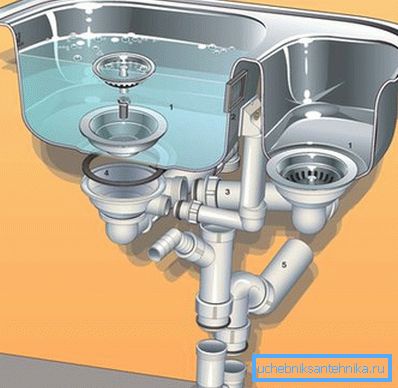
Product Description
Design options
The sink, like any plumbing fixture, is designed to collect wastewater and divert them to the sewer. And it is precisely the place of contact of the sink with sewer pipes that requires some protection: otherwise unpleasant odors will penetrate the room.
The most effective way to organize such protection is the arrangement of a hydraulic seal - a section of a pipe or a separate container in which water is constantly located. Such a water block serves as a barrier to sewage gases, and therefore we do not feel “odors” from the sewer drain collector in our apartment.
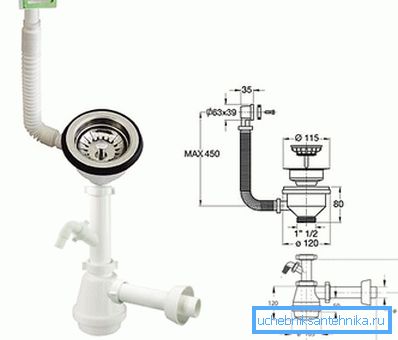
That is why the connection of the sinks to the sink is necessarily carried out through a siphon, which can have a very different design:
- Bottle - has a fairly rigid structure with a good margin of safety. The main element of the product is the flask, inside which is located the drain pipe. The outlet to attach the siphon to the sewage is located in the middle part of the flask, because at the bottom there is sometimes solid waste that requires disposal.
Note! This design provides a number of advantages to the siphon. For example, if during dishwashing you drop a ring in a sink, it can be very likely to be found at the bottom of the flask.
- Pipe it is distinguished by a simpler design, since it is a pipe section with a characteristic bend. The lower part of this system performs the function of a water seal, but in it, as in the flask of the previous variety, solid particles accumulate. For this reason, when choosing a design, it is worthwhile to give preference to collapsible products: it is much more difficult to wash monolithic ones.

- Corrugated - the simplest in structure. In fact, it is a segment of corrugated pipe, on which the lower loop is formed with the help of plastic ties. The siphon can take almost any shape, but the instruction recommends avoiding strong bends, since they reduce the throughput of the product.
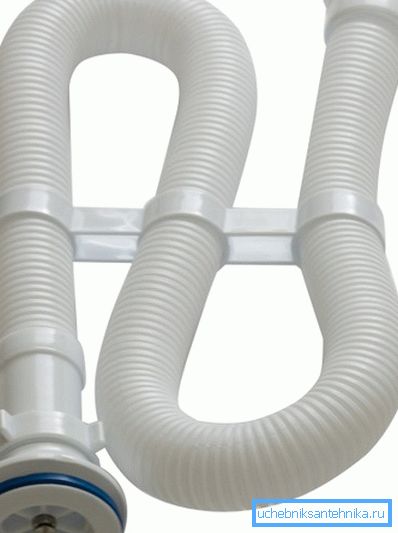
- Dry siphon - quite an original design, which is used where the most compact dimensions of the product are needed. Here, instead of a water seal, the odor barrier is an elastic membrane that opens only under the action of water flow. However, the service life of such a product is small, so it should be mounted where we use the sink not too often, for example, in the country.

Of course, here we have resulted only the most general description of constructive schemes. In fact, in each of the described varieties you can find more than a dozen models. However, there are not many significant differences between them, so for a meaningful choice of this information it will be quite enough.
Manufacturing material
Another parameter by which the sewer siphon is usually selected is the material from which it is made. Today, both plastic and metal varieties are on the market.
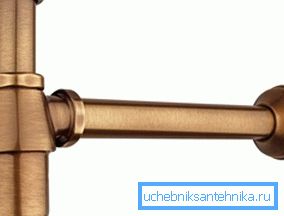
Note! Metal products are most often made of bronze and brass, but sometimes there are also steel chrome-plated devices. However, preference should be given all the same models of non-ferrous metals, since they are much less susceptible to corrosion.
The following table will help us analyze the pros and cons of basic materials:
| Material | Merits | disadvantages |
| Plastic |
|
|
| Metal |
|
|
As you can see, both options have pros and cons. And yet, if the siphon is placed openly, then it is better to install chrome or brass, since they look not as an example more attractive than standard plastic products.
Additional details
As a rule, universal models of siphons are chosen for sinks.
However, they may have additional features that will be very useful:
- Firstly, if you have a sink with several bowls installed, you do not need to purchase a separate appliance for each. A double (or even triple) siphon is usually completed with one rather large flask, to which are connected several supply connections from a rigid or corrugated pipe.
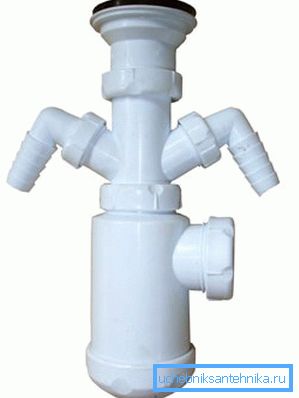
- Secondly, on the siphon itself, you can install an outlet for a washing machine or dishwasher. Such a drain is a tubular valve that allows to drain large volumes of water in a short period of time. Attaching a drain to a siphon is preferable, since this is how we get the water seal we need, not only in the kitchen sink.
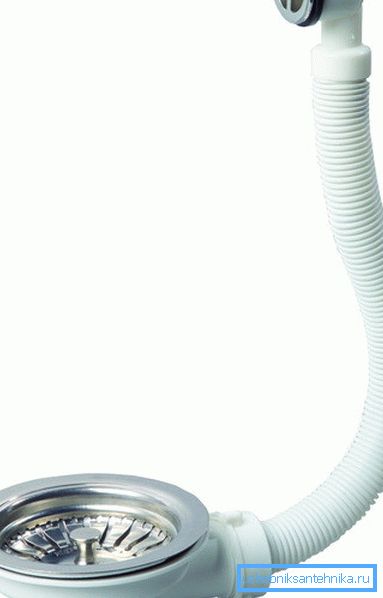
- Thirdly, almost all shells today are equipped with overflows. The overflow is a hose that is connected at one end to a hole in the upper part of the sink, and the other end to a siphon flask or a bent pipe. The main function of this part is to prevent the sink from overflowing and water overflow.
Most manufacturers produce siphons with the ability to install such elements, so finding a model that is suitable for functionality is not difficult. And then we will only have to install it correctly, which we will discuss in the next section.
Installation technology
On how to install a siphon under the sink, and how to mount overflow, often ask beginner wizard. In fact, this procedure is quite simple, and having mastered it once, you will not have difficulty.
The installation process is carried out as follows:
- Before starting work, dismantle the old siphon, cleaning the sink drain and pipe on the sewer pipe from contamination.
- Then in the sewer drain we install a rubber cuff that will provide a tight connection of the siphon outlet.
- Attach the drain part to the sink bottom. For fixing, reliably tighten all the nuts.
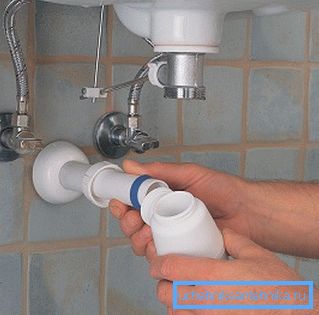
Tip! Do not overtighten the threads, as this can lead to pipe deformation and leakage. This requirement will be especially relevant for plastic products.
- Then we screw on the bottom part of the flask or attach the pipe bend.
- We fix a hose with an adapter on the overflow hole of the sink with a fixing tint. We make sure that the rubber gasket in size corresponds to the dimensions of the overflow hole and adjoins the sink as closely as possible.
- If the sink is made of ceramic, the overflow should be fixed especially carefully, taking care not to damage the material.
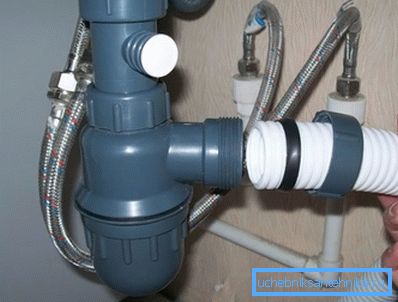
- Next, we introduce a drain pipe into the sewer drainage, fixing it with a cuff. If a straight pipe is used, it must be cut to size with a margin of about 5 mm.
- We carry out a test drain, checking the tightness of the connections. Most often, problems arise in the fixing unit of the flask, so that if necessary it is possible to seal the joint with a sanitary roll.
If all the details were originally intact, then the installation process itself will take no more than half an hour.
Conclusion
Siphon for a ceramic sink with overflow, as well as for a metal sink, is a fairly simple product. And yet, it is worth installing not any model at all: the characteristics of the siphon depend not only on its type, but also on the material from which the part is made. More information about the selection and installation of such products is described in the video in this article.